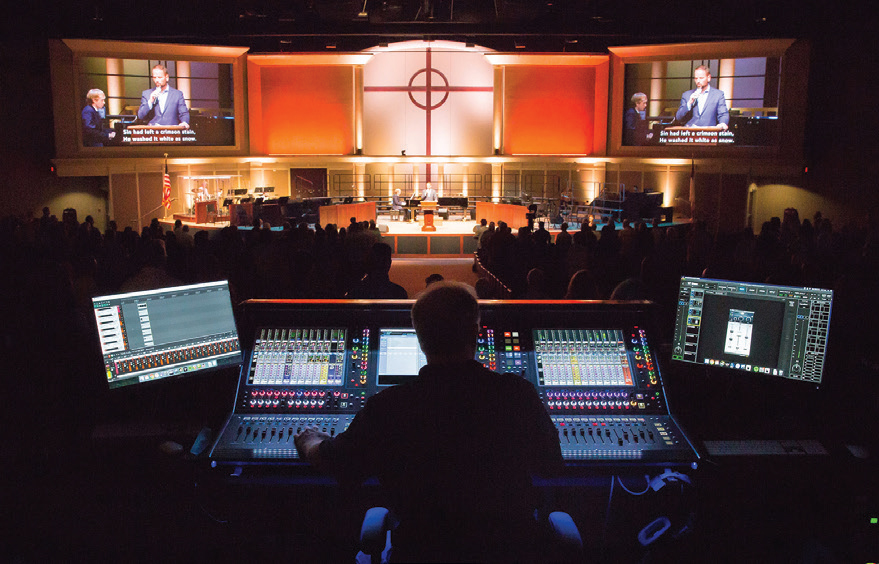When I first started mixing in 2017, there were a lot of things that attracted me to the skillset. The art, the ever-evolving technology, the working relationships with other technicians. But the main thing that really sparked my love for audio engineering is the fact that by running sound, I’m making people feel things in the most unconventional way.
Now of course, the musicians have something to do with this. You’d be hard-pressed to find an effective mix when the band isn’t in the pocket or hasn’t learned their parts. Likewise, the band could be doing exactly what it’s supposed to do and if the front of house engineer isn’t getting the mix right, the music won’t translate to those who stepped into an auditorium expecting to hear something perhaps life changing. The songs won’t send the message they were written to send.
When it comes to music, all churches have the same goal: to create a worshipful experience for the congregation. Of course, this looks different for every church. But regardless of the size, the band, or the denomination, the same person will always play an impactful role in this mission: the mix engineer. But how? What are some practical and intentional ways to do this? Here are some of my key places of focus.
Vocals
A crisp lead vocal is always extremely important when it comes to mixing for a house of worship. As noted, there’s nothing more important than passing on that message. I usually boost around 10 kHz and carve out any “mud” between 250 Hz and 500 Hz.
The corner frequency (where the filter is said to begin, at -3 dB) of my high-pass filter (HPF) always depends on the qualities of the specific vocal. For example, our worship leader has deep gravelly tones to his voice that I like to preserve, so I don’t get overzealous on the HPF.
Ultimately, the goal isn’t to let the lead singer overpower the band — rather, it’s to constantly think about carving out space in the EQ so the vocal can sit nicely in the mix while also cutting through.
Subwoofers
I understand that subs can be controversial when it comes to houses of worship. Many people feel uncomfortable with the “thumpity-thump” of the sub in their chests.
That’s why I ride it. In moments where the music crescendos right after that down chorus at the end of the worship set, I push that sub on my aux send just a couple of decibels to add to the moment of elevation in a subtle and physical way. The congregation feels it, but they don’t even realize because it’s happening at an intentional moment, matching the energy of the music and the lights, it works.
Songs
Learn the songs that the band will be playing that day. Especially if they are looking to replicate the recording pretty closely, it’s extremely helpful to listen to and to know what to expect.
When in the song is that lead electric solo happening? Or which instrument is playing that hook during the pre-chorus? Should I expect the vocalist to “belt it out” at a specific moment?
Distractions
Most importantly, every single weekend I want a distraction-free mix. I’m fortunate to usually have a band that is pretty much in the pocket, so it makes this job easier to accomplish.
To provide a mix free of distraction, I’m always paying attention to the context of the stage. Who’s singing harmony? Are they normally “pitchy”? Does the bassist play lightly during the verses but start smacking the neck during the chorus? Does the lead vocalist tend to be very sibilant or nasally?
If I pay attention to these context clues, it can help in limiting the distractions within the set. I try to learn each band member’s individual playing and/or singing styles beforehand so I know what to expect.
Years ago, I was taught by a dear mentor and professional in the industry that the front of house engineer is “the fifth member of the band,” and that’s how I’ve thought of it ever since. I actively participate with the band because I’m mixing for them, looking up at them, recognizing their successes on the stage.
You’d be hard pressed to find an audio engineer who lifts their hands in worship as they mix, but I have found that it not only engages the band but encourages them. A fired-up band will only produce greater music. As a team effort, we can accomplish our goal of passing a message to every person that walks into the auditorium.
Unfortunately, this job is often understated and many mix engineers (especially those who are volunteering, perhaps out of obligation or habit) aren’t aware of the important role they play. This can happen because they’re not empowered by leaders or trained up to learn their specific console inside-out or think about why they make decisions. Perhaps the volunteer just doesn’t care to take the extra time to learn and try new things.
How to steward, protect, and raise up volunteers is a topic for another time. But let’s simply start with this: each person that walks into a hazy auditorium is a recipient of a message that may change lives.
Whether they come to church habitually or are visiting for the first time, it’s an opportunity. Everything they hear is first filtered through our fingers. What an honor that is. Our mixes matter. Let’s be intentional.




















